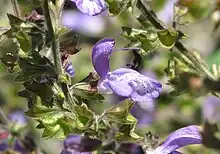| Salvia forsskaolei | |
|---|---|
 | |
| Scientific classification | |
| Kingdom: | Plantae |
| Clade: | Tracheophytes |
| Clade: | Angiosperms |
| Clade: | Eudicots |
| Clade: | Asterids |
| Order: | Lamiales |
| Family: | Lamiaceae |
| Genus: | Salvia |
| Species: | S. forsskaolei |
| Binomial name | |
| Salvia forsskaolei | |
Salvia forsskaolei is a herbaceous perennial plant endemic to the southeastern Balkan peninsula, ranging from Bulgaria and Greece to the Black Sea coastline of Turkey. It grows up to 6,000 ft (1800 m) elevation in broad-leaved and coniferous forests, meadows, and on steep banks. It was named after Finnish explorer and naturalist Peter Forsskål, a student of Carl Linnaeus who collected plants in southwest Arabia in the 18th century.
The plant grows into large basal clumps 2 ft (0,6 m) tall and wide, with hairy leaves that are parsley-green in spring, turning dark green in summer. The flower whorls are few and widely spaced, with the flower a showy two-lipped violet-blue color that has white streaks with yellow markings on the lower lip.[1]
Notes
Wikimedia Commons has media related to Salvia forsskaolei.
- ↑ Clebsch, Betsy; Barner, Carol D. (2003). The New Book of Salvias. Timber Press. p. 120. ISBN 978-0-88192-560-9.
This article is issued from Wikipedia. The text is licensed under Creative Commons - Attribution - Sharealike. Additional terms may apply for the media files.